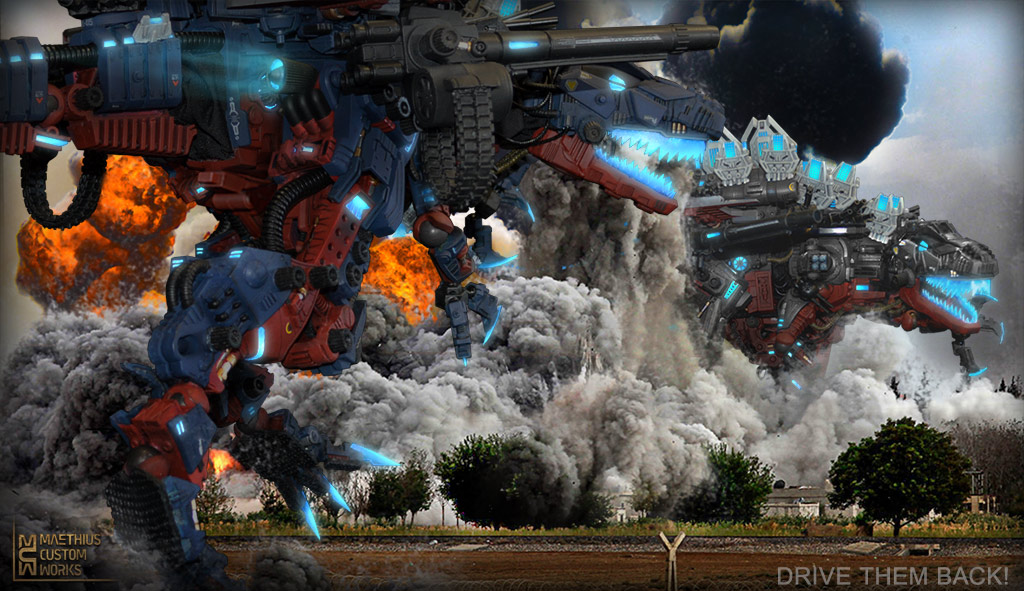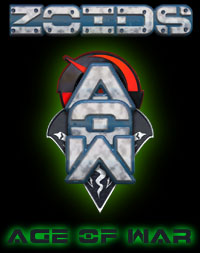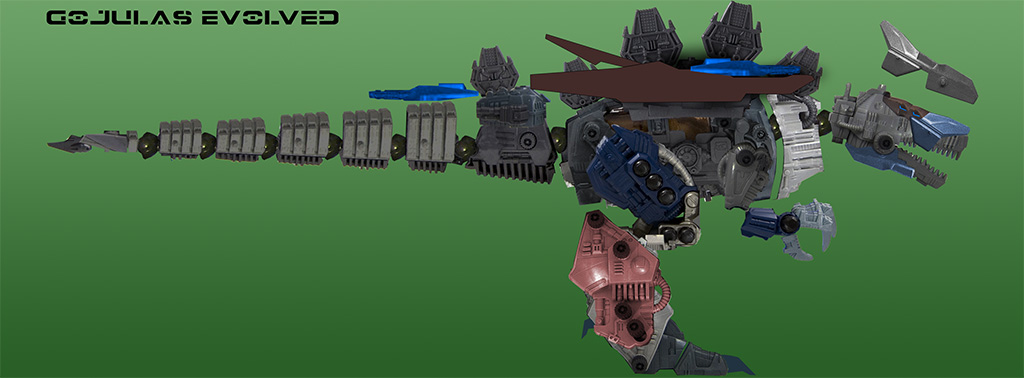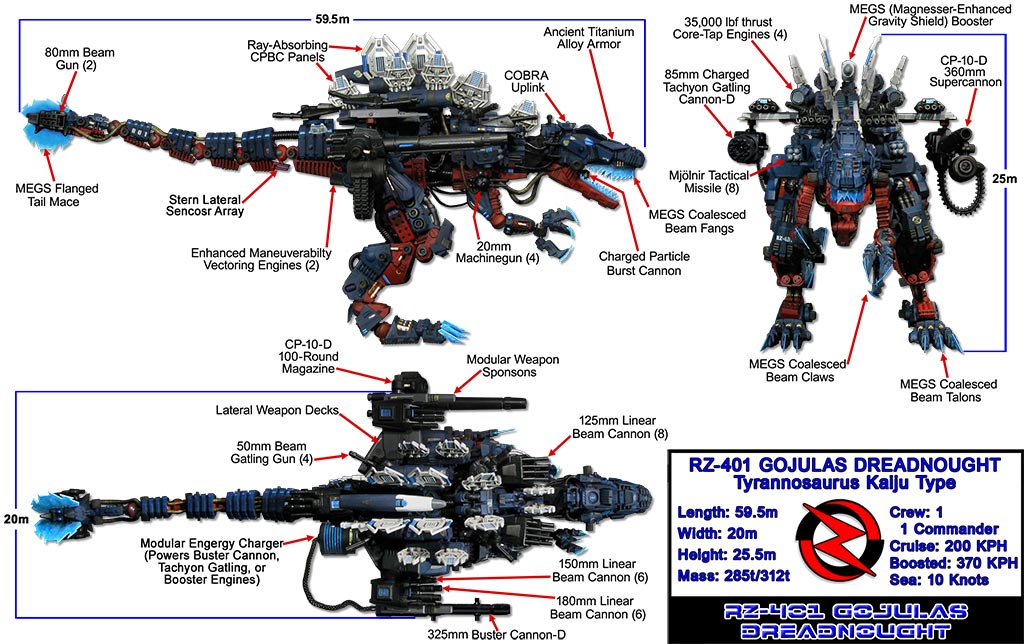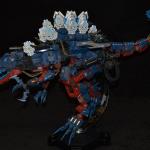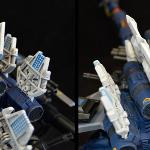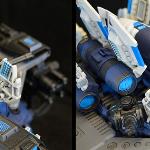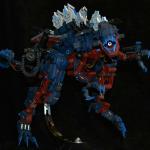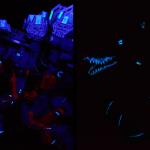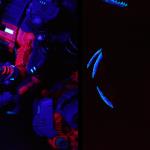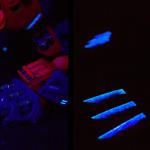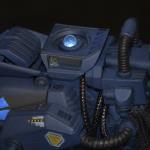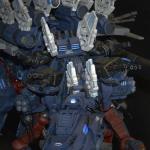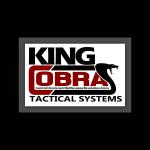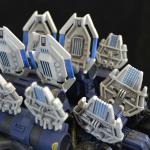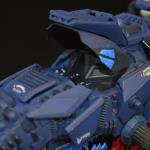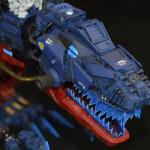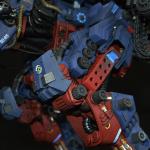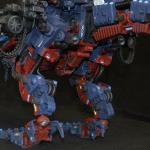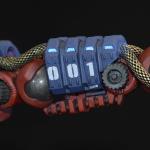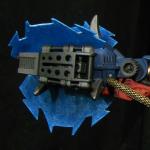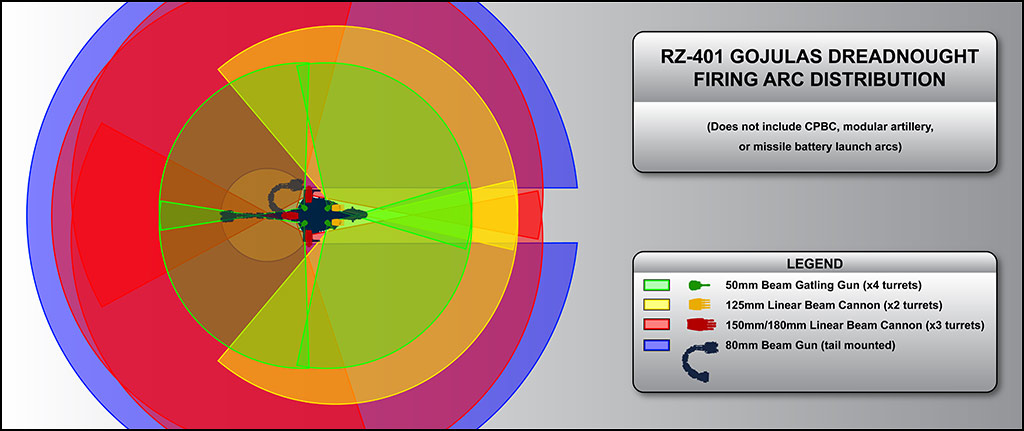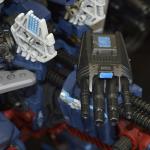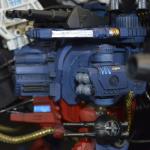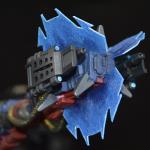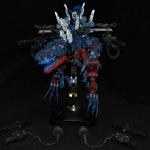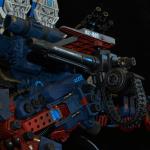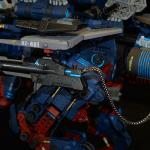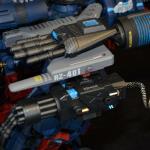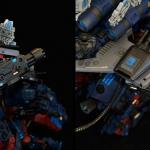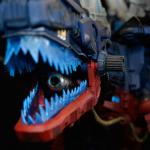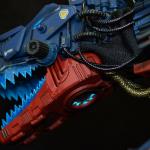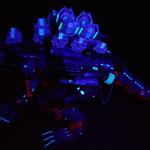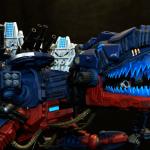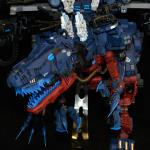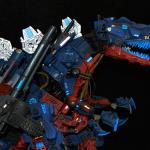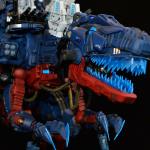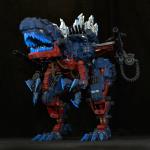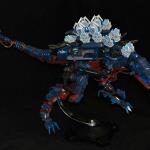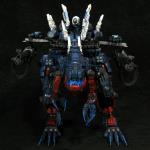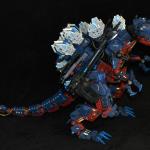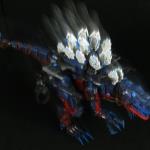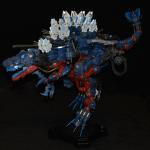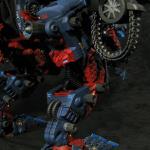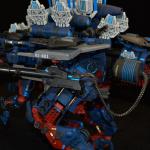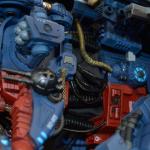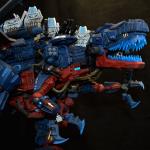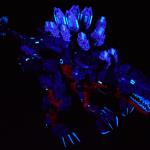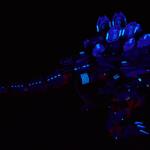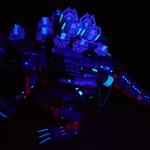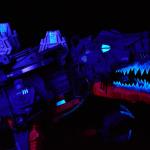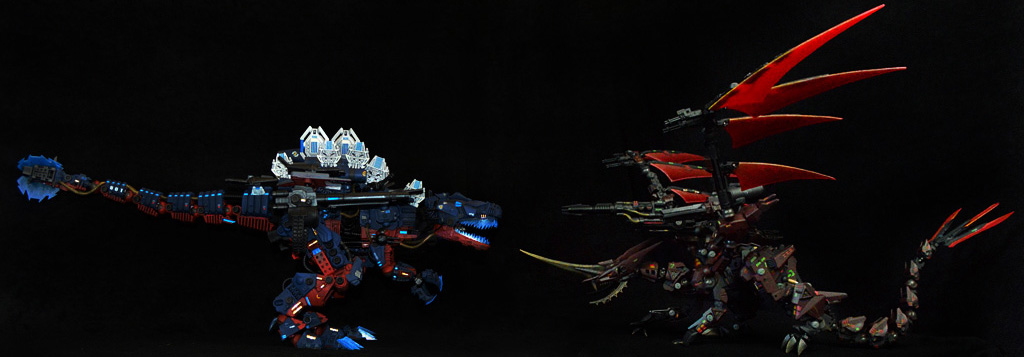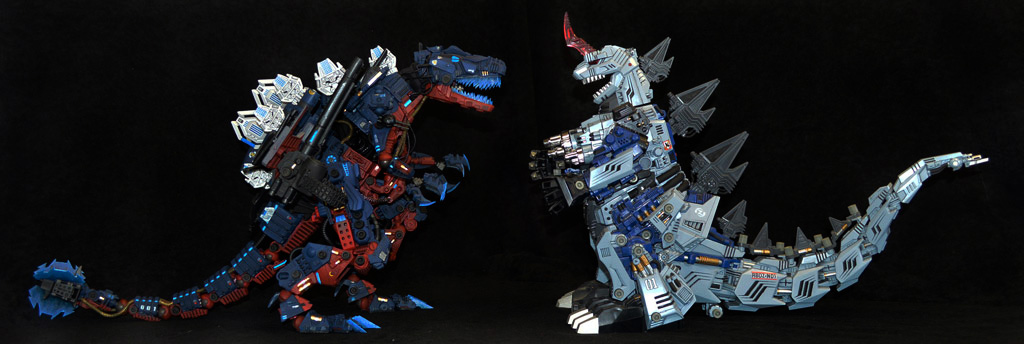HALF AND HALF
The OJR lower leg gave me what I needed to shroud the new knee joint, another first, it is a double Struxx joint that creates a very strong hinge. The issue I had with the legs was that only the outer piece would work as a femur, so I cropped the femur pieces from both the Terrox and an old NJR Gojulas together. The Struxx structures are wedged in so tight that they didn’t require adhesive. I actually drove a plastic post through the two halves and then a screw through the entire thing just below the knee.
MORE BLOWBACK
I wanted to use the old Giga foot joint for something, so I added vectoring engine bells that can aim directly to the rear regardless of leg angle. They add large boosters below the hip, which gives it a more balanced look while enhancing the speed factor... Dreadnought now has SEVEN large boosters to push it forward. I also see these as jump jets that allow this massive Zoid to leap through the air and slam onto an Iron Kong from a 250 meters away.
TAIL ASSEMBLED!
Structurally, I really love how the tail turned out. The pegs and caps will have to be replaced for the final look, but mechanically the tail is very strong and carries a good balance of OJR and Giga features. It is heavy, but it turns out that was a requirement to balance the model.
DEFENSIVE BATTERIES
I decided to go with the Rhimos guns, but rather than create some 2-barrel 120mm guns I opted for 50mm quad-barrel Gatlings to be used as both missile defense and to pluck softer targets apart without requiring the use of the Dreadnought’s main armament; the 150mm and 180mm turrets.
TWIN-TWINS… PLUS ONE
I chopped one engine off of each Terrox backpack and then swapped and remounted them. This allowed the packs to be mounted to the sides of the spine and gave a splay of four boosters reaching forward over the waist. Between them I mounted a whiteout correction pen for an additional, higher-tech booster. The pen works, so the button forms an intake that can close and slides a directional vane out the back.
BACK IN SHAPE
The engines bring the custom's width to 11 meters (6 inches). They don't interfere at all with waist movement and are high enough to mount side wing/gun battery decks without interference. In addition to using the Gojulas quad-turrets, I tested a Black Rhimos sponson as a temporary gun emplacement to protect the flanks. At this stage I was attempting to find the balance between boosters, guns, articulation, and spine shields.
MEGS BOOSTER
Details of the white-out pen re-appropriated for the booster. The button retracts to open up the intake while the vain extends and on the other end. The details of the pen are difficult to see due to the clear plastic. To mount it within the boosters, I used two Gungyalados spare parts to create the support. The cut posts were smashed so they could hold the larger caps used by the Gojulas.
SERIOUS BACK ISSUES
With FIVE large boosters the Dreadnought is beginning to look like it can run a sprint, if not a marathon. You can see in the first picture how the booster arch around the waist joint, allowing it to bend all directions without striking chest to intakes. Now that I had the vast majority of the body work concluded, it was time to stand this thing on its own two feet.
FLIPPIN’ AND SWAPPIN’
As the massive body took shape I needed larger legs. I took the huge lower legs from the Giga and flipped them to make up the bulk of the thighs. I took the thigh pieces and swapped them around making them into the tops of the new thighs. Inside these new thighs I shaped, screwed, and glued a heavy Struxx framework for the joints. This is the first time I have actually built a completely internalized joint: the thigh joints are built to have the ball snap in from the top so that the cup carries the weight of the model. It can pop out of the cup, but the ball can’t slip out of the thigh box… it is in there forever!
CAST
Robostrux Terrox X2
Base kit
NJR Gojulas
Inner calves, aft gun turret.
Gojulas Giga
Tail, thighs, dew claws, skull,
Power exchanger, outrigger decks
Command Wolf
Head armor
Elephander
Dorsal sails
Buster Eagle
Buster Cannons
Baragator
CP-10-D ammo hoods
Redler
CP-10-D coolant hose
Shield Liger Commander
CPBC barrel
Energy Liger
Generators, Charged Gatling
Black Rhimos/Metal Rhimos
50mm Gatling turrets
Hammerhead
Tail Dorsal Sails
RBOZ-030 PALADIN - 2007 Phenotype Contest Entry
This is truly a monster of a page; perhaps you should get some coffee...
Built for
GOJULAS DREADNOUGHT
Chassis: Tyrannosaurus Rex
Power Plant: RBOZ 400-B – Biped, Class III)
Primary Mission: Frontal Assault
Secondary Mission: Tactical Support
Crew: 1 - Pilot (minimum rank requirement: General)
Statistics
Length: 59.5 meters (OJR = 26m))
Width: 20 meters (OJR = 17m)
Height: 25 meters (OJR = 21m)
Mass: 285 tons (OJR = 230 t)
Performance
Land (Cruise): 200 KPH (OJR = 75 kph)
Land (Boosted): 370 KPH (Giga = 111 kph)
Sea: 10 knots
HISTORY
The RBOZ-024-X Supreme King Gojulas was designed to be the ultimate Helic battlefield unit, but it was also the most complex and expensive Zoid Helic had ever engineered. To lead multiple forces into battle, a lower cost, high capability unit was required. Using the FEF (Forced Evolution Facility) to upgrade Zoids had been tried successfully on a smaller scale, but Helic’s Chief of Evolutionary Engineering opted for a test that was convinced that she had a solution to expedite the creation of a new front-line unit. She convinced the king to order the classified military technology archives to be opened to her unit, and they acquired the corpses of one of the very first Gojulas and the first Gojulas Giga Zoids. Further the Wild Capture Team acquired a wild Tyrannosaur. These three Zoids were locked into the FEF and the process was triggered… the result is the RZ-401 Gojulas Dreadnought.
CAPABILITIES (Performance)
The goal of the Helic military commanders was to generate a Zoid that fulfilled three primary charictaristics: 1) it needed to be exceptionally durable, 2) it needed to carry an array of firepower required to challenge superior enemy numbers, not merely a super weapon with limited application, and 3) it needed to fast; fast enough to keep pace with modern allied and enemy ground forces. In this last aspect, speed, the Dreadnought excels. Thundering across the battlefield, it cruises at 200 kph across clear terrain. With the aid of seven booster engines it can reach a flank speed of 370 kph and maintain that pace for three hours. The Dreadnought is capable of charging alongside the Ligers.
CAPABILITIES (COBRA Interface)
Gojulas Dreadnought incorporates the King COBRA (Central Omniscient Battlespace Resolution Array) tactical system that allows it to integrate information with all allied units within a designated zone and maintain constant communication with the Supreme King Gojulas. In the case of the Dreadnought, the system can also be used at the battlefield level to track and engage multiple targets simultaneously.
AI-2 PROFILE
The template for the Dreadnought’s AI-2 system was that of a mother Tyrannosaurus crossed with the more primitive control algorithm of the RBOZ-003 Gojulas. It was discovered that the T-Rex female possessed superior situational awareness and reaction times due to her protective instincts; this married well with the multi-weapon control core used by the original Gojulas enhanced with the COBRA system. Hence, Dreadnoughts are all considered female, are acutely aware and capable of engaging multiple enemies with ease.
THE BUILD
BIG, STRONG, FAST
Quite simply, my client wanted to evolve an OJR Gojulas into a silhouette that more resembled an actual T-Rex. I suggested that, perhaps, combining it with a Giga could take us down that road and give a nice variety of parts to work with. In the end, we also wanted the Gojulas to more resemble a ship of the line rather than just a big lizard with some small guns. I had NO idea just how this monster would evolve to overwhelm that simple plan.
AN OPPORTUNITY WAISTED
My original design did not feature an articulating rib cage because, quite frankly, it looked like an ugly prospect and it was painful with Gungyalados Mk2. The new head was immense compared to the old body; I needed to stretch the torso. I cut the body in half just in front of the structural rib. I also decided to flip the body upside down, placing the battery compartment on the Zoid’s back to preserve the wonderful details! The details lined up almost perfectly, so the cut didn’t meander like my initial plan. The chest plus head would weigh so much that I needed to use a large Struxx joint to pull it off.
GOING HEADLONG
I had to cut the nose off of one Terrox head and then the whole muzzle off of another one… I also had to trim the new one down a notch to make it look a little sleeker. This resulted in my having to extend the lower jaw to match. At this point one runs into another major design difference between OJR and Giga; OJR had a vertical neck and Giga’s was horizontal. Cutting the neck off the OJR results in a huge hole, of course. The next thing you discover is that the OJR can’t open its mouth very far, but the Giga could.
BASIC DESIGN
Originally I wanted to articulate an OJR Gojulas and add some more modern armor elements. This included using a Giga tail to armor the skeletal OJR tail. I wanted to stretch the head and narrow the snout, and I had the idea of using the armor of a Command Wolf to cover the more vulnerable aspects of the head. As the design evolved (hence the working name) I realized that the legs would be woefully small and entirely the wrong shape, and so I looked to the scrapped Giga for solutions. Finally, it was decided that to two features to highlight this custom; 1) we wanted it to have powerful boosters to emphasize it as a fast Gojulas, and 2) we both liked the idea of using CP-10 support turrets to create more of a battleship effect.
A DINO’S HEART
It is always a fun challenge to try and place ball joints and the structures to support them. I have been learning more lately about how to set them so that limbs work better, such as mounting the balls to the joints at the torso side and the cups on the limbs. There are several screws holding different parts throughout this whole build because I knew the weight and torque issues would be second to SKG.
A WEIGHTY TAIL
To my knowledge, an OJR Gojulas tail is the largest, heaviest, and thickest single Zoid part ever made. I had hacksaw and Dremel it apart; all the red stuff is discarded. I originally thought of just slicing through the "joints" and mounting the actual Struxx joints there... which would have worked very well and would have taken one tenth the time. However, I wanted to retain the mounts for the rubber caps because those are iconic of the OJR, and they are completely lacking on the Giga. I briefly thought about cropping those uniform "saddles" (the top pieces of the molded tail segments with 3 lines and a ridge each) but I realized that I may need the structure to build on and the weight to balance out the massive head.
REDEFINING "BATTERY BOX"
This is the basic tail segment plan (well, sans prettying it up). For the first segment I actually decided to make a solid Struxx core rather than mount the two joint parts. I drilled out the entire red section and lanced the whole spine through. It works flawlessly... I don't even think any adhesive or screws are required! I was sad to lose the cool armor on the sides of the OJR tail, but the pieces fit perfectly without it, and the armor made the tail way too fat and tall... I would have had to butcher either the armor, the Giga pieces, or both to make it work. In the last pic you can finally get a real sense of how things are shaping up! Note that I have swapped out the center ball joint for a double; which is essentially a left-right hinge. I am tightening the ball joint, but this is my backup plan... there is a lot of weight on this joint, so I want it to be strong without requiring breaking-level torque.
NECK RE-ALIGNMENT
After designing the torso, I switched back to the head. Having plugged up the old vertical neck hole, I had to build a rear, horizontal one. I screwed a Struxx joint through the old weight compartment. I then attached the joint cup to the OJR neck with a locking washer and screw to make it absurdly strong. I should note that the head alone weighs about as much as the old OJR Sinker. Having lined up the new neck, I thought about how I could use the split battery cover and decided one of my larger chains looked like a huge power cable; a theme I wanted to carry from skull to tail tip.
LAYER UPON LAYER
To really complete the look I was going for, I ended up chopping the Command Wolf armor apart and applying it like large scales over the OJR head. This made the head look even tougher. I placed the Giga brow ridge plate on the OJR canopy, too, which made it look meaner still. With all of this piled on, the Dreadnought’s head was essentially three layers thick and yet still functional.
JAWBREAKER
So now I had to combine the outer look of the lengthened OJR jaw with the functionality of the Giga jaw. These parts just would not go easily together, so I had to chop out just the hing from both jaws and meld them together. That solved one issue, but it made a design issue glare at me; the back of the head seemed too abrupt. I cut off the weight box from Terrox #2 and used it to extend the weight box of Terrox #1. Now we were getting somewhere.
I’M A FAN
I looked everywhere for options to plug the bottom of the jaw. At first I thought I wanted to use a turbine fan from a locomotive, but it seemed like an odd place for that feature. I settled on using the wheel from a cheap tractor toy which fit perfectly into the gap. It has the look of some kind of intake but one that is heavily armored. This works well with my goal of including a killer mouth cannon, too.
CAPABILITIES (Melee)
All of that speed is made more terrifying when coupled with the Zoid’s infighting prowess. The RZ-401 is incredibly agile, able to dance through and around opponents where it can claw, bite, and slash at will. Its massive jaws are equipped with MEGS powered, coalesced beam fangs that practically ignore physical armor of any kind and can defeat energy shields. The same technology is used in its claws and talons, whose longer limbs afford them great range and wide arcs. Finally there is the huge tail mace which is equipped with beam blades, hyper alloy spikes, and extra thick ancient titanium alloy armor. More terrifying, the Dreadnought can use its boosters in combat to dodge, strike, and even leap more than 200 meters to savage its prey.
THREE HEADS ARE BETTER THAN ONE
As I played with combining two Terrox heads it became apparent that the OJR head is little more than a large, empty box. It was a challenge to fit the muzzle pieces together … that would be easier over some kind of structure. Using the Giga head proved to be an ironic help; the old head basically became armor over the new; it also gave me a way to include the roof of the mouth that covered the ugly mess it became inside, and a way to swap out teeth for my latest concept that would set this model apart from all others I had seen: beam teeth and claws. No simple glowing anime feet here, I wanted the Dreadnought to have actual energy field based melee weapons like the SKG, but in a very different capacity. By using the Giga head, if this idea did not turn out at all well, I could just swap the normal teeth back in! The design and build of the head alone took 10 hours.
GAINING TRACTION
As with the SKG, Dreadnought relies on rubber pads on the bottom of her feet. While the model is perfectly balanced without them, the pads add that much more stability and allow more diverse posing. My usual Loctite glue won’t work on the rubber, so they use Gorilla Glue to maintain their strength.
THE FIRST TAIL SEGMENTS
A constant among customs with long, jointed tail, each segment looks very similar on the outside but ends up coming together uniquely within. The first tail segment is a really large chunk of plastic which I drilled a hole clean through and installed a solid Struxx spine. The Giga tail was chopped into armor to modernize the tail while the ORJ underside kept the old aesthetic. The cables really help tie it all together. In the end the first tail joint had to be replaced with a large, steel screw-reinforced joint.
LESS OF THE SAME
Working toward the tip the OJR core pieces and Giga pieces continue to taper, leaving less room to do the same thing. Unlike other prior builds, though, the Dreadnought’s tail continues to use Struxx joints to the end. I considered adding just one more between the last segment and the tail mace, but it was just getting too tight in there.
FORMERLY SOLID FOOTING
The OJR Gojulas required two huge, flat feet and a pair of wheels to stand on solid legs; Dreadnought is twice the size as the original and must stand on only the balls of its feet (the toes provide very little strength or stability) on articulated legs. The new feet were cut to flex at the ankle, the ball of the foot, and the toes… roughly 1/3 of the area of the OJR. I had to build very solid internal parts with larger Struxx pieces and multiple screws to resist torque. The toes were added because the feet had to be up-scaled to match the much larger body.
TACTICAL FIREPOWER
We decided to move the arms lower on the body which left large gap to fill. These Warhammer 40k weapon kits fit perfectly. Each can carry a variety of weapons, but I wanted to emulate a bit of the Ogre and so chose the heavy missiles. The system allows full rotation on two arcs and has a cool sensor head that aims in direction of the pod. Because the system clicks on with a magnet, my client can swap it out with other options in the future.
125mm “HEEL” GUNS
My polystyrene tubes wouldn't fit the ports of the turret, so I used the tubes from different soft soap dispensers. This stuff is hard to shape because it shreds a bit, so I left the muzzles cut rather than filed down. Through all of these tubes and the turret housing I placed a brass rod, which keeps all of the barrels quite snug.
GALLERIES
A BRIGHT, SHINY SMILE
One of the first features I really wanted to attempt on this model was to use common sci-fi beam blade technology to create a wicked set of teeth out of energy. My client loved the idea, and it made sense; Zoids are renowned for their animal-based attacks, and the Gojulas has the most fearsome bite of them all. I decided to cut teeth from a transparent blue storage bin and replace the teeth on a Giga jaw with them. I kept a spare jaw just in case the project turned out poorly. Fortunately, they turned out pretty much perfect!
INTERLOCKING KNIVES
The lower teeth were much easier to create! They interlock perfectly with the upper teeth, creating a wall of deadly blue shards. I figure that I will paint the glow toward the points so they will have definition like the Gungy wings did with the lights on or off.
CHARGED PARTICLE BURST CANNON
I have been wanting to use this piece for years; the chuck from my very first Dremel. It is mounted on an unused piece from my Shield Liger Commander. I stuffed three layers of polystyrene tubing in the Zoid piece so that I could drill a hole through it and the plastic at the back of the jaw, then drive a screw through the assembly. The gun is big but doesn't protrude much into the mouth so it doesn't interfere with the bite. Also, it looks very large but doesn't compete with the SKG's enormous cannon.
DREADNOUGHT vs. GOJULAS GIGA
The second model that makes up a large poriton of this custom's construction, and the kit to which it most resembles in stance and proportion, is the Gojulas Giga. The prior "super hero" of Helic's line, it donated several of its features to Dreadnought such as its ancient titanium armor, power core, and shielding, and improves on them all. Dreadnought and Giga are evenly matched in many ways, but the RZ-401's stealth allows it to move in close, and once those MEGS blades begin their work there will be little left of the Giga.
DREADNOUGHT vs. OGRE
The Zoid that Dreadnought most resembles is a cross between the Gojulas OGRE and the Gojulas Giga. As large as Dreadnought is, it is still closest in size to OGRE. The eye can be fooled, however; the tail is half-again wider, the head longer and taller, and the legs are fully twice the mass, as are the CP-10-D class compact Supercannons. Facing each other, the OGRE would last only moments, and in melee, not even that.
DREADNOUGHT vs. UMBRA MORTIS (GUNGYALADO MK][)
The captains of the Royal Court series of customs, both share heavy armor embude with stealth suites, devastating firepower that includes fully automatic charged particle cannons, high maneuverability, the latest in shielding technology, advanced AI2 systems, abundant beam blades, and clean Deochalcum power cores. Between the shielding and absorption plates, most of the Gungy's beam weapon advantage is nullified. In the end, should these two face off, the Umbra Mortis has far superior speed and the melee advantage with its massive wing blades and longer and more agile tail blades.
DREADNOUGHT vs. KING GOJULAS
From a model size standpoint (though I'm not certain about the lore on the KG) These two monsters look almost even here. Of course the KG has twice the mass in its legs and almost three times the mass in the torso and tail. Dreadnought's armor, shielding, and energy mitigation abilities could allow it to get close enough to bring its MEGS weapons to bear, but even the CPBC alone is capable of picking the KG apart with a few lucky hits. In the end, this fight would be a pretty even match. As an aside, the standing position of the Dreadnought was an afterthought... and looks fairly awsome.
INTERESTING BITS
Dreadnought has come to represent a new level for me in keeping a design true to the original animal (well, with some enhancements). Its balance is nearly perfect, able to stand on just 2" of foot area for a biped model 28" long. The Dreadnought may well have earned its place as my favorite custom to date.
Hours to complete: 90
Articulations: 84 (Dreadnought only) + 8 for modular heavy weapons
Model length: 28" (71.2 cm)
Shipping weight: 10.6 lbs (4.8 kg) ... Dreadnought only = 5.25 lbs
Build Firsts:
- First attempt at beam teeth and claws
- First use of completely internal joints
- First use of conduit for major aesthetic components
- First use of hinged rather than universal load-bearing leg joints
- First time creating a set of modular weapons
- First time building a custom stand
LATERAL WEAPON PLATFORMS
Extending over each leg is a platform which mounts a main turret and artillery connector; we refer to them as “outriggers.” I wanted a way to suspend the guns to the sides so they could cover fore and aft arcs. I used the Giga’s “walking feet”; the parts are not used to display the Giga. They required very little modification. Each one is screwed to the booster pack and also uses the OJR foot support as an underside support structure.
SHIELD TURRETS
A lot more work went into changing the CP-10 shield guns into articulated turrets. The guns had to be cut off the shield, the sensor box removed, then the armor opened up to allow barrel elevation. I had to cut styrene tubes to extend the barrels into the gun and more tubes to attach the original gun barrels to the new ones. I drove a pin through the entire assembly; it was the shaft taken from a Zoids gear assembly… and this had to be done with three turrets. I used one of Terrox’s leg bearings as a rotation collar on the bottom of the turret, and then I made a deck of styrene so it didn’t look so hollow.
20mm Linear Beam Gun (x4) – arm mounted in 2 turrets, forward arc
The lightest weapon carried by the Dreadnought, each shoulder carries a 20mm twin-beam turret used to engage light units without devoting heavier weapons to the task. Each gun fires a beam capable of penetrating 5 cm or armor at a range of 4 kilometers.
50mm Beam Gatling Gun (x4) – torso mounted in 4 turrets, 90º corner arcs
More robust versions of the SKG’s internal guns, the 50mm BGG turrets were adopted to fill two roles: close-in projectile defense and to inflict heavy damage on light units without utilizing heavy weapons required for larger targets. They can deal significant damage to heavy targets out to 2 km, tearing light Zoids to pieces at up to 4km.
80mm Beam Gun (x2) – tail mounted, 220º rear arc
Concealed beneath protective armor plating, the tail cannons provide decent armor penetration at ranges up to 6 kilometers. The system is robust to withstand impacts and does not rely on ammunition, but is still considered unreliable after heavy tail use.
125mm Linear Beam Cannon (x8) – dorsal mounted in two batteries, lateral arcs, 100º rotation
With a 1 shot per 5 second fire rate, these guns can penetrate up to 30cm armor at a range of 5 km. They are considered the lightest of the Dreadnought’s mainstay weapons. They may fire in tandem for a continuous barrage, as a single salve to deal heavier damage, or individually to save power versus many light targets.
150mm Linear Beam Cannon (x6) – dorsal mounted in three batteries, lateral and rear arcs, 180º rotation
Considered the Dreadnought’s median weapon, the outer pair of guns located on each of the three main turrets balance damage, range, and power use. The 150mm beam cannons can only fire once every 7 seconds and can penetrate 40cm of armor at 10 km.
180mm Linear Beam Cannon (x6) – dorsal mounted in three batteries, lateral and rear arcs, 180º rotation
The largest weapons carried in the Dreadnoughts mainstay battery, they are the inner pair of guns located on each of the three main turrets. These guns can only fire once every 10 seconds due to energy use and heat, but they can punch through 50cm of armor at 12 km.
Mjölnir Tactical Missile (x8) – dorsal mounted in two batteries, 180º universal rotation
These large fire-and-forget missiles are carried in batteries of 4, one launcher being located above each shoulder. They have a range of 80 km and are equipped with heat and silhouette seeking, armor penetrating, high explosive warheads capable of scrapping most targets on impact. They can be locked onto Zoids, vehicles, structures, and even terrain to destroy subsurface targets.
MEGS Coalesced Beam Fangs – head mounted, integrated construction, forward arc
Using the same technology as the SKG’s terrible blade weapons, although on a much smaller scale. The bite of the Dreadnought can slice through virtually any material with virtually no resistance. Even uncharged, the teeth have a crystalline structure akin to diamond and can sunder heavy armor.
MEGS Coalesced Beam Claws (x2) – arm mounted, forward arc, 100º universal range of motion
As with the teeth, so with the claws. The claws can shred armor and defeat shields, but even when left unpowered the Dreadnought’s titanium allow claws can still rip a Zoid apart.
MEGS Coalesced Beam Talons (x2) – foot mounted, integrated construction
Again, the talons are powered through MEGS generators. These weapons are most often powered down unless the Dreadnought is engaged in a tough melee battle against multiple foes. Unpowered, the tremendous kick of the Zoid can still crush an Iron Kong to the ground.
MEGS Flanged Tail Mace – integrated construction, tail mounted, 220º rear arc
Dreadnought’s tail is as long as that of the SKG, but the mace is twice as heavy. Though it can deal crushing damage on its own, it can charge three MEGS flange blades to shatter energy shields and sunder even the toughest foes.
SUMMARY
The RZ-401 Gojulas Dreadnought was created to fill the niche between the standard Gojulas heavy field units and the King Gojulas class super-heavy warzone command Zoids, and it does so perfectly. Its firepower makes it the bane of entire battle herds of standard field units while its devastating close-in power is the terror of even the largest adversary Zoids. Its armor and shield power range its field survivability into months rather than hours, and its speed ensures that it can lead forces from the front. The Dreadnought is, by all measures, a fully successful implementation of the Forced Evolution Foundation technology and will doubtless spawn many progeny.
FORWARD GUN DECKS
Having split torso I was required to split the original gun deck plan. This was made even more obvious when the arms were moved lower on the body… now I needed a way to mount cannons over the shoulders. I used the OJR inner thigh pieces as they had a convenient overall shape, but also had a perfect hole to mount the forward turret and a raised platform to mount a second, smaller gun. I opted to make another pair of Gatling turrets using a set of Metal Rhimos sponsons. You can see the broadside potential in the last frame: 4 each 125mm, 150mm, and 180mm guns plus a pair of 50mm Gatling guns. Note, also, the missile turret mounted beneath the gun deck.
BEAM TALONS & CLAWS
Since the teeth went well, it made sense to propagate the technology to other melee attacks. I trimmed the toe claws which made them look more like the OJR toes (I reserved the spikes can be mounted on the mace, below). I then cut slashes through them and installed a set of beam blades. I then cut similar slits in the hand claws and placed smaller, curved blades there.
THE TAIL MACE
Honestly, I wish I could have done this with the SKG. I was inspired by the design of the Gojulas from Zoids Era which has a flanged tail mace. I opted to move ahead with the mace over a smoother tail for two main reasons: 1) it afforded better balance for the huge head, and 2) it seemed fitting for a powerful Zoid more so than a blade. The metal weight was simply too heavy for the joints, so I combined the OJR tail with the Giga tail, which was a poetic fitting. I then applied the claws I trimmed as physical spikes. I also played with restoring the original guns, but they were too vulnerable to damage.
BLUNT AS A RAZOR
Soaking the guns in Simple Green stripped the chrome and left me with what looks like a shot something between Goldschlager and absinthe. I used two Giga tongues to encase the guns in armor to protect them from impacts. Finally, I cut out some beam flange blades for the mace to carry on the beam-melee theme. They are actually the same shape as the spinal sails, carrying that theme on as well.
COMPARISONS
BUSTER-D” CANNONS
“D” for “Dreadnought,” these guns are modified to mount to the outrigger ports and are shortened so they afford a greater melee capability. The Busters have a magnet attached at the back so that they can attach to a pair of generator “magazines.” made from the Energy Liger’s charger system.
TACHYON GATLING-D
I spent 45 minutes modifying the first Gatling cannon to mount on the outrigger, but built the second gun in 15 minutes without having to make a single adjustment! The gun has the internal components removed to reduce weight; the gears were kept to stabilize the gun barrels. These, too, have a rear magnet that allows the client to swap them for the Busters while using the same generators to power them.
DEFENSES
The RZ-401 uses a combination of defense elements gleaned from its contemporary units. The body is reinforced alloy but is covered with “floating plates” of armor based on Giga’s ancient titanium alloy. To reach the physical body, enemies must bypass a slimmed-down version of the SKG’s MEGS (Magnesser Enhanced Gravity Shield), which redirects both energy and projectile attacks. Prior to even engaging the shields, however, foes must defeat the potent ECM suite that confounds sensors and targeting systems.
ARMAMENT (Optional Mission Systems)
The RZ-401 is designed to support a pair of heavy external systems in support of different missions at the extremities of the lateral gun decks. Three of these systems are included here, but others include missile launchers, melee blades similar to those used by the SKG, universal defense gun batteries, e-shield generators, ECM or electronic attack units, and additional booster engines.
300mm/325mm Buster Cannon-D – torso mounted, forward arc, 90º horizontal rotation
The mainstay direct fire beam cannon developed for the Buster Eagle, the Buster Cannon type D was developed as a self-contained version that lacks the Zoid core tap power requirement. The weapon is designed to breach heavily armored and even e-shielded units thought is superior at the former. The –D configuration can be equipped with the standard long barrels to destroy even heavy Zoids at 20 km distant, but can also use shortened, 325mm barrels that spread damage over a wider area at half range.
85mm Charged Tachyon Gatling Cannon-D – torso mounted, forward arc, 90º horizontal rotation
A technology acquired from Neo-Zenebas sources through clandestine means, this is a faithful reproduction of the Energy Liger’s devastating weapon. Charged tachyons can bypass e-shields and rip apart the energies holding molecules together, essentially disintegrating any matter struck by the ray. In effect, the CT Gatling can shred through any number of targets out to 12 km.
CP-10-D 360mm Supercannon – torso mounted, forward arc, 45º horizontal rotation
The CP-10-D has had its barrel length reduced by 4 meters in order to reduce interference with the Dreadnought’s melee capabilities. This has reduced the effective range of a standard APEX projectile from 24 kilometers to only 20, and the accuracy suffers about 10% drift. The –D system, however, alternates between standard and shotgun 360mm rounds; the ammo controller can skip shells to afford continuous fire or either type, and has had the limited box magazine replaced with a 100-round drum with shell return belt system. Shotgun rounds spray an Iron Kong sized target head to toe at 5 km and are used to ravage battle herds of smaller Zoids or to knock out sensitive systems on heavy units at a distance. The CP-10-D can maintain a 3-rounds-per-second rate of fire for 10 seconds at a time, thanks to a new cooling system.
DOUBLING BACK
Stretching and jointing the back created a small cascade of design changes, not the least of which was what to do with the OJR’s iconic booster pack? My first plan was to just use both packs one on each segment, but that made positioning awkward and led to a strange arrangement of the front boosters blasting into the rear boosters.
SOLID WAIST MANAGEMENT
The hip is in a seemingly strange place given that the original leg port is 1” away: this clears the bulk of the leg’s motion, has more solid plastic to reinforce and stabilize the joint, and ended up being an excellent center of balance. The complex Struxx "jacks" I mounted internally are screwed into the hip shaft in two places and are screwed to the body in four places. The upper balls were left on the jacks because they couch and stabilize the tail structure. You can see in the last shot how the hip shaft fits from the back; the joint doesn't need a lot of lateral movement.
HEAVY CABLES
Since SKG used up a ton of my heaviest and best chains, I needed to dig around to find some suitably robust cables for Dreadnought. While I had a handful of thick mesh chains, I also decided to try some ¼” plastic conduit. This stuff is really thick so I could only use it in specific places, mostly from the neck to the second tail segment. Each location for these large cables must be anchored at one end and permitted to slide at the other, so even if cables seem to transition from section to section, there is actually a gap between them inside each piece.
WE CON-DUIT!
The cables are much larger on this model than prior builds, and some of them actually aid structurally in the legs, midsection, and keeping the tail up.
CP-10-D SUPERCANNONS
The most ambitiously modified on the Dreadnought, I wanted to include the CP-10s because they are iconic of the Gojulas. My client and I discussed how to include them, and we both felt they could should be shortened because the Dreadnought is such a melee monster. I cut 3” off the gun barrels to start with, but that wasn’t nearly enough. I cut off the box magazine and converted it to a feed system, using a large rubber tank tread as an ammo feed belt.
CP-10-D DRUM MAGAZINE
Each drum is made from a pair of soft soap pumps, capped on one side by another soap dispenser part on one end and a water bottle cap on the other. I secured the mounts clipped from the Buster Cannons to mount the drums to the CP-10 armature pegs. In the end I swapped out the Gojulas caps for a pair of Liger Zero caps to finish the guns because the Gojulas caps hung out too far and the LZ caps could be slipped inside the drum, which looked much smoother and more intentional.
FED AND COOLED
Thought the tank tracks looked impressive enough, they seemed too thin for such a large gun; I opted to double them up so they appear large enough to carry bigger ammunition. The hood the covers the insertion point on the drum was clipped from the belly of a Barrigator. Finally, to warrant the huge drum I decided the CP-10-D should be fully automatic. To enable such a huge gun a high rate of fire I added a cooling system to it using pieces from a Klingon Bird of Prey, a hose from the Redler I used to make Lucht Vuur, and some capacitors to resemble coolant bottles.
A PLETHORA OF PAINT OPTIONS
There is a magical time in the designing of a custom when it is time for the client to solidify their vision of the model’s paint scheme. While we didn’t have as many options on the table as Dreadmander, we knew we wanted to pay homage to the great seafaring dreadnoughts of the WWI and WWII era. To this we decided that this model would be a deep sea blue with a dark red “waterline” featured as the prototype, black guns would accent it as they had all previous models of the Royal Entourage line. The second favorite was battleship gray with red waterline, which we decided would be used for the production type Dreadnought units.
THEY EYES HAVE IT
The last matter of paint to decide was the configuration of the eyes. As I had effectively merged the heads of two OJR and a Giga, we felt it would be cool to configure the eyes as though two heads had merged together. The final choice was to have a pair of eyes on each side of the head.
NON-ZOID PARTS
Warhammer 40k Sponson System
Mjolnir Missile Launcher
Struxx
Joints & internal structures
Asoblocks
Joints & internal structures
Bionicles
Forearms, torso intake fan
Klingon Bird of Prey
CP-10-D coolant system
Soft Soap Pump (x4)
CP-10-D ammo drum, 120mm gun barrels
Bic Whiteout Pen
MEGS Mobilization Amplification Unit
1:34 Tank Track
CP-10-D ammo belts
1/4" Plastic Conduit
Heavy cables
Electrical Box Plug
Energy Charger Intake
Dremel Chuck
CPBC muzzle
Toothpaste Caps
Vectoring Thigh Booster Bell
Gundam Shoulder Missile
Vectoring Thigh Booster Cone
Plastic Storage Box
Beam teeth and claws
CAT Tractor
CPBC intake fan
Styrene Sheets & Tubes
Many structural parts
Necklace Chains
Multiple cables
Cloth
Weather seals
Ray Absorbing Charged Particle Burst Cannon – Head mounted, forward arc, 90º universal rotation
Both a defensive and offensive system, this is an updated version of the Gairyuki's weapon fitted for a more rubust platform. The dorsal plates absorb energy of different types, from solar power to beam weapons to the shot from a charged particle cannon. The gun itself is the same weapon found on the SKG’s tail; comprised of four CPCs that fire cyclically. The Dreadnought must minimize power to all MEGS weapons to engage this gun, but it can saw through a 300 ton Zoid at 10 km or tear apart a battalion of 50-ton Zoids at 25 km. The effect of the weapon on early versions of the Dreadnought was part of the reasoning behind the MEGS fang innovation; the CPBC’s sustained fire was melting the hardened alloy teeth.
ARMAMENT
Unlike the prior four Gojulas variants (SKG, King, Giga, and Ogre), the Dreadnought was intended to act as both a local battlefield fire platform and a deadly melee combatant. Apart from the original rendition, all other Gojulas units were essentially carriers of some direct fire super-weapon or a tactical, mass damage system. Dreadnought bristles with medium range firepower but also carries a few tactical and short range options, essentially equating as a battle herd with mulitiple 360º effective arcs.
A T-REX TITAN
Dark Dreadnought
DREADNOUGHT vs. SUPREME KING GOJULAS
The RZ-401 is a bastion of advanced military technology, but the best of it was forged into the SKG. While the Dreadnought is faster and more agile, there is little doubt that the SKG's weaponry outclasses it from horizon to melee. SKG wins the bout easily. It should be noted from a model building standpoint that both of these customs ended up being very similar in effort. It is difficult to choose a winner from that context; a close call indeed!
STAND
Logitech BLAH Controller
Base
BBQ Fork
Steel stand arm
Hardware
For assembly and weight
Cloth
Padding
DREADNOUGHT vs. DEATHSAURER
Its a good thing that the Zoids battle story decided that the mighty Deathsaurer isn't in scale, because... yeah, it's dead.













